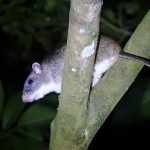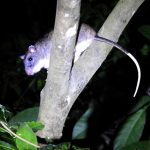GIANT WHITE-TAILED RAT
The Giant white-tailed rat is a fascinating creature native to Australia, particularly found in the lush rainforests of northern Queensland.
It is aptly named, with its most distinctive feature being its long, white-tipped tail, which can measure up to 35 centimetres. This tail is not just for show; it helps the rat balance as it navigates the treetops. Its body is robust and covered in thick, greyish-brown fur, providing excellent camouflage among the forest foliage. These rats are quite large, with a body length of up to 30 centimetres, making them one of the largest native rodents in Australia.
Giant white-tailed rats are primarily found in the tropical rainforests of northern Queensland, from sea level to the mountainous regions. They are arboreal, meaning they spend a lot of their time in the trees, although they do come down to the forest floor to forage.
Giant white-tailed rats are omnivorous, with a diet that includes fruits, seeds, nuts, and occasionally small animals or insects. They are known for their strong jaws and sharp teeth, which they use to crack open hard-shelled fruits and nuts. In fact, their ability to gnaw through tough materials is so impressive that they can even chew through coconuts! They play an important role in their ecosystem by dispersing seeds through their foraging activities, which helps to maintain the health of the rainforest.
Breeding for the Giant white-tailed rat can occur year-round, but it often peaks in the wet season when food is abundant. Females typically give birth to one or two young after a gestation period of about 30 days. The young are born blind and hairless, relying on their mother for warmth and nourishment until they are ready to venture out on their own.
In the wild, the lifespan of a Giant white-tailed rat is not well-documented, but it is estimated that they can live for several years if they avoid predators and other dangers.
Currently, the Giant white-tailed rat is not considered threatened and is classified as Least Concern by the International Union for Conservation of Nature (IUCN). However, like many rainforest inhabitants, they face threats from habitat destruction and climate change, which could impact their future populations.
These rats are generally quiet, but they do communicate through a series of squeaks and grunts, especially during social interactions or when alarmed.
the Giant white-tailed rat is a remarkable example of Australia’s unique wildlife, showcasing the adaptability and resilience of species that thrive in the diverse and often challenging environments of the rainforest. By understanding and appreciating these creatures, we can better appreciate the delicate balance of our natural world and the importance of conservation efforts.


